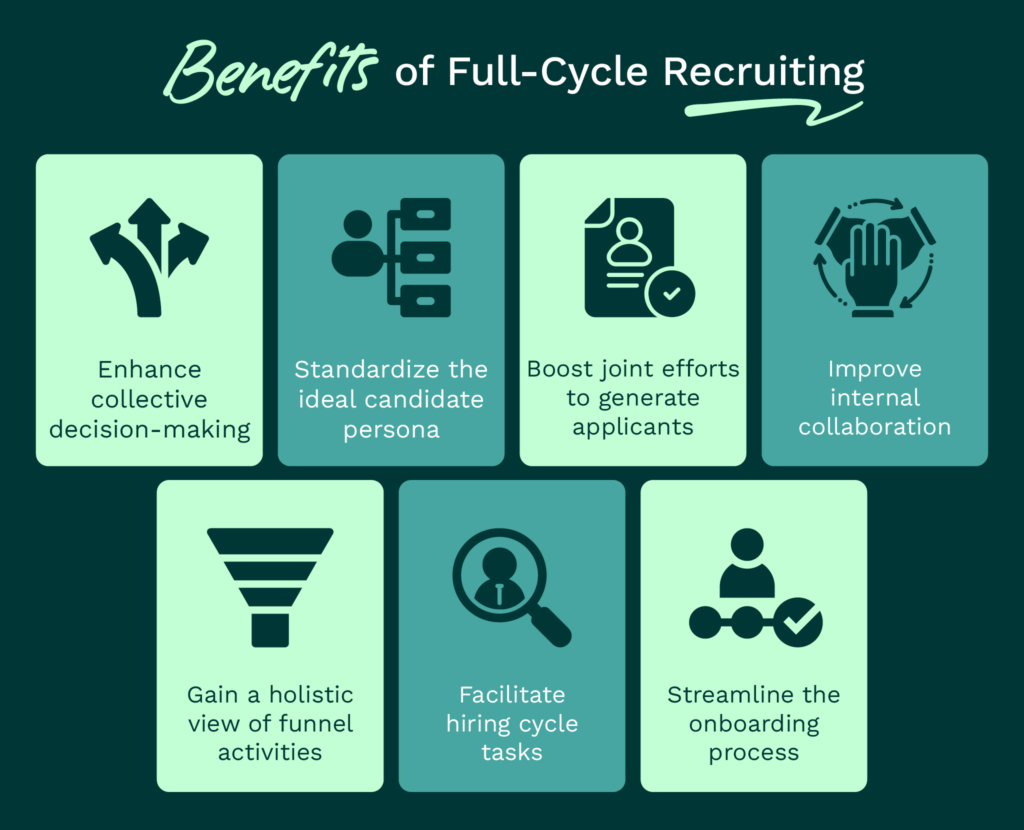Do your current talent acquisition (TA) technology and processes form a streamlined, well-run end-to-end recruiting machine? If not, it’s worth assessing your current recruitment approach to determine where improvements can be made to better achieve your goals. That’s where full-cycle recruiting comes in.
A full-cycle recruiting strategy that involves talent acquisition (TA), human resources, interview panelists, and executive decision makers is how leading organizations boost their candidate conversion rates and outcompete other employers for top talent.
In other words? Hiring teams that take a coordinated, standardized approach to preparing, sourcing, screening, selecting, hiring, and onboarding talent can execute each of these stages of the full-cycle recruiting process — and fill open positions — efficiently. Become a full-cycle recruiting expert with the tips in this guide.
- Full-cycle recruiting FAQs
- Steps to build a scalable, full-cycle recruiting process
- Jumpstarting full-cycle recruiting with TA tech

Full-cycle recruiting FAQs
What is full-cycle recruiting?
Full-cycle recruiting is a progression of six stages in the TA process. These stages include:
- Prepare: Recruiters have conversations with hiring managers and write impact job descriptions.
- Source: Recruiters publish listings to job boards and proactively engage talent.
- Screen: Strong-fit prospects hop on a call to discuss the role/company.
- Select: Structured interviewing and feedback collection lead to offer extensions.
- Hire: Hiring managers and recruiters work hard to “close” candidates of interest.
- Onboard: Recruiters transition candidate hand-off to HR and the hiring manager.
This is a general overview of the full-cycle recruiting process. Each organization has its own practices that fit into every stage based on its open positions and team preferences. That said, following these steps in this order can be beneficial for TA teams across industries.
Who’s involved with full-cycle recruiting?
Regardless of your organization’s size, your hiring process is not handled by a single recruiter. It’s a true team effort, from your candidate experience approach to your efforts to build a diverse workforce. Here are some internal players involved in the full-cycle recruiting process:
- Hiring managers
- TA specialists/recruiters
- HR professionals
- Interview panelists
- Onboarding specialists
What are the benefits of full-cycle recruiting?
By implementing full-cycle recruiting into your workflow, your organization can:

- Enhance collective decision-making
- Standardize the ideal candidate persona
- Boost joint efforts to generate applicants
- Improve internal collaboration
- Gain a holistic view of funnel activities
- Facilitate hiring cycle tasks
- Streamline the onboarding process
Your candidates will appreciate your full-cycle recruiting approach as well. A study from BCG found that two-thirds of job seekers said organizations stand out from competing employers by adopting a full-cycle recruitment process.

Steps to build a scalable full-cycle recruiting process
The talent shortage is real. Following The Great Resignation, many employers are still struggling to fill open roles across their business. In fact, studies show that more than 85 million jobs could go unfilled by 2030, amounting to $8.5 trillion in unrealized revenue.
Due to these tough hiring conditions, it’s more crucial than ever to have an effective and scalable full-cycle recruiting process that attracts top talent and retains them in the long run.
Here’s how you can put a high-converting TA approach in place, ensure you perfect each part of the full life cycle recruiting process, and regularly hire high-quality candidates today.
Leverage a high-quality applicant tracking system (ATS)
The most crucial contributor to your success is the quality of your ATS and candidate relationship management (CRM) software. Audit your tech stack to ensure that you have a solution that can:
- Manage talent pipelines
- Support Diversity, Equity, and Inclusion (DEI) initiatives
- Increase funnel progression speed
- Automate key tasks
- Create actionable, data-driven reports
- Facilitate team collaboration
- Provide candidate-facing features

Ensure that you find a solution that fits your organization’s budget, tech-savviness, and price point. Collect feedback from candidates, whether they get hired or not, on their overall experience and interactions with the software.

Ensure your TA and HR teams have integrated full-cycle recruiting tech
If you’re like other organizations, your TA and HR tech stacks are separate solutions. However, some of these solutions — notably, your ATS and HRIS/HCM software — work much better when they can sync information, like candidate and employee information sets, with one another.
Why? Only when the solutions and tools used by talent acquisition and human resources “speak” with one another can your business build a high-functioning full-cycle recruiting process. When you have tech that supports these efforts, you can eliminate data silos and have a truly integrated full-cycle recruiting process.
The best way to check if your solutions integrate is to consult your vendors directly. Most vendors have integration pages that provide in-depth information about which solutions integrate with their products. If you still need assistance getting set up, work with the vendors or external integration consultants.
Develop your recruitment marketing strategy
Recruiting diverse candidates is an important part of strengthening your hiring class, but it can be challenging without powerful marketing outreach. That’s why optimizing your recruitment marketing efforts should be a priority.
Whether you’re starting from square one or improving your existing strategies, follow these steps to ensure a solid approach:
- Increase awareness of your employer brand
- Generate interest in your brand and active roles
- Promote applying via job boards or your career site
- Nurture candidates into the decision-making phase
- Gauge effectiveness and iterate on strategies
Remember to collect feedback from the most important stakeholder group: your candidates. Poll them throughout the process about how they found your organization, so you can efficiently allocate resources. Also, tailor your recruitment marketing efforts to highlight your unique value propositions to stand out from competitors.
Continually refine your candidate sourcing and nurturing activities
Where you source candidates and publish job postings, and how you engage qualified candidates with nurture messaging, are critical in determining the success of your full-cycle recruiting.
Regarding sourcing, evaluate your efforts to date by asking questions like:
- Are we using social media sites like LinkedIn and niche career communities like Wellfound?
- Are we using the right search criteria when sourcing via LinkedIn Recruiter?
- Do our job ads hit the mark in terms of generating clicks and applications?
- What about the conversions of our other recruitment marketing assets?
These channels and other job boards like them are proven outlets for identifying the best talent. Just don’t forget that successful sourcing also entails reexamining leads in your existing candidate relationship management database. Develop a cadence for revisiting leads and developing tailored outreach strategies for this segment.
Routinely optimize interview, job offer approval, and onboarding processes
Once a candidate has demonstrated interest and qualifications for the role, you need to keep them engaged throughout the final stages of the process. Let’s tackle each of these respective full-cycle recruiting phases separately:
- Interviewing: Whether you’ve returned to conducting mostly face-to-face interviews or prefer recruiters, hiring managers, and interview panelists to speak with prospects over the phone or Zoom about open roles, you still need to routinely refine your interview approach.
- Offer extension: When you get to the offer extension phase of your full-cycle recruiting process, you must collect feedback from each hiring team member. You need to loop in hiring decision makers and get the green light to send an offer to the preferred candidate quickly to avoid losing them to another job offer.
- Onboarding: Ensure new hires hit the ground running by orienting new employees to the company culture and answering their questions. These are all tasks that TA and HR teams must tackle together amid an employee’s onboarding process to help them start their jobs on the right foot.
When you and your hiring team work closely together in the entire full-cycle recruiting process, you can streamline candidate engagement and analysis. This collective work, in turn, helps you realize your desired growth goals and fill critical headcount company-wide.
Jumpstarting full-cycle recruiting with TA tech
Optimizing your full-cycle recruiting is only possible with intuitive TA tech. If you’re a high-growth organization that needs a seamless CRM and ATS system, Lever is the best option for you. Find out how 5,000+ Lever customers implement full-cycle recruiting strategies and enhance every part of their recruiting process with LeverTRM.



